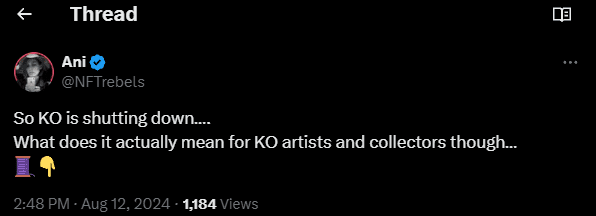The realm of Non-Fungible Tokens (NFTs) is in a state of perpetual progression, introducing innovative ways to store and sell digital art and collectibles. However, this advancement is not without its complications. Technical hurdles abound, creating a landscape that can often confound both the creators and collectors navigating it. A stark illustration of these challenges was brought to light by Ani from NFTRebels, who delved into the vulnerabilities surrounding KnownOrigin (KO) art tokens on Etherscan. The crux of the matter lies in the misconception about the security of the art files linked to these tokens and the complexity of the technology involved, which can be overwhelming for the less technologically adept individuals.
The Problem: Where’s the Art?
An attempt to locate a KO unsold art KODA token on Etherscan reveals an unsettling scenario. The expected digital artwork, artist’s credentials, or associated image are conspicuously absent. Instead, what one encounters is merely the basic token data and a hyperlink redirecting to the artwork’s files on the IPFS (InterPlanetary File System). The predicament, as pointed out by Ani, is that the genuine art, its metadata, and cover image are ensconced within these IPFS files, and accessing them is not as intuitive as one might hope.
Understanding IPFS and the Importance of Pinning
IPFS represents a revolutionary, decentralized method of file storage, reminiscent of the peer-to-peer sharing platforms of yore like Napster. Its decentralized nature ensures that files are dispersed across a multitude of nodes instead of being stored in a singular location. Although this architecture implies that artworks are not stored directly on the blockchain, they have the potential to be preserved indefinitely on the IPFS network, provided they are pinned.
Pinning refers to the act of maintaining a file’s accessibility on the IPFS network. Without pinning, and if a file is not regularly accessed, it runs the risk of becoming inaccessible over time. This presents a significant issue for NFTs — if the linked files disappear, it would render the NFT devoid of its associated art and metadata, leading to broken links and considerable confusion and distress amongst collectors and creators alike.
Enter SoulKeeper: A Simple Solution for Artists and Collectors
To counteract this issue, Ani, alongside Rick, conceived SoulKeeper. This tool has been meticulously crafted for KO artists and collectors, assuring the enduring accessibility and safety of their art files. Utilizing SoulKeeper doesn’t require extensive technological knowledge; a KnownOrigin wallet address is all that’s necessary. The tool locates all KnownOrigin art files linked to the user’s KODA tokens and facilitates either manual downloading for pinning or automatic pinning via Pinata, a widely utilized pinning service.
The sheer accessibility and cost-effectiveness of SoulKeeper — being free to use — emanate from Ani and Rick’s genuine dedication to supporting the community and safeguarding their digital art. This solution stands as a beacon for those seeking to mitigate the potential headaches associated with the preservation of digital artworks.

Why This Matters
The unveiling of SoulKeeper is not merely the introduction of another tool; it signifies a pivotal moment underscoring the criticality of grasping the technological foundations of NFTs. As this domain expands, the demand for tools that facilitate the protection and management of digital assets is increasingly evident. SoulKeeper epitomizes a safeguarding mechanism for your art in the decentralized, often erratic expanse of IPFS.
TL;DR:
SoulKeeper emerges as an innovative tool crafted to assist KnownOrigin artists and collectors in effortlessly pinning their NFT art files on IPFS, thereby guaranteeing their persisting accessibility and security. Its cost-free nature and simplicity in handling make it an indispensable asset for any member within the KO community.
Conclusion
As we sail through the digital age, the intersection of technology and art continues to evolve, sometimes in ways as unpredictable as the art itself. SoulKeeper represents a beacon of hope, not just as a technological marvel, but as a testament to the power of community and collaboration in the digital art space. It’s a siren call to those who value the permanence of digital art on the blockchain and a reminder of the collective effort required to preserve our digital heritage.
So whether you’re an artist, a collector, or simply an NFT enthusiast, the tale of SoulKeeper is more than a lesson in technology; it’s a story about safeguarding the future of art in our increasingly digital world. And perhaps, as you take your next steps in the vast world of NFTs, you’ll find solace in knowing tools like SoulKeeper exist, ready to aid in your digital art preservation endeavors. The art of tomorrow is in our hands today; let’s ensure it endures for generations to come. For more engaging articles and to stay abreast of the latest in digital finance, make sure to visit DeFi Daily News.



















